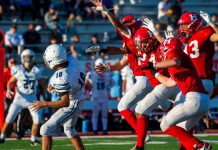In cross country, more so than probably any other sport,
athletes rely on a running regiment that prepares their bodies to
peak at the right moment.
Hollister – In cross country, more so than probably any other sport, athletes rely on a running regiment that prepares their bodies to peak at the right moment.
Where practices consist of miles upon miles of running, the bodies of cross-country athletes need to be in tip-top shape to ensure a smooth transition from off-season training into preseason practicing.
“You can see the difference in the athletes who train all season,” said boys cross-country coach Jess Morales. Both the boys and girls squads are defending champions of the Tri-County Athletic League. “The ones who do [train] come out and are ahead of schedule.”
Erik Rodriguez, 16, a junior at San Benito High School, runs with his brother, Adrian, five to 10 miles a day, six days a week in the off-season. They also hit the weight room, but not to be big and bulky.
“Triceps and chest,” Erik said. “It helps you get up the hills. You don’t want to be big – it’s all repetitions.”
The two brothers run year-round, except during volleyball season in the spring, when they take a break from their arduous running schedule. Of course, as soon as volleyball is complete, they’re back running long distances.
“(Cross country) transfers to volleyball, but volleyball doesn’t really transfer to (cross country),” Erik said. “As soon as volleyball season is over, I start running again. But I do take volleyball off (from running).”
Frankie Rivera, 15, also a junior, opts for track and field over volleyball in the off-season.
“During the off-season, I train just as much as I do during the season, if not more,” he said.
Rivera, who does ab workouts, long distance running and track and field, also runs in the Tri-County Running Club, which was set up by Coach Morales, and supports athletes to train during the off-season.
While five to 10 miles may seem like a push for some, it’s all in an effort to peak at the right moment toward the end of the season. And when practices start in early August for the ‘Baler boys, the squad works and trains just a little harder.
“If you miss one day, it’s like missing two,” Rivera said. “The first week is horrible.”
Added Erik, “We come back to practice and I’m sore again … You get sore to get back into shape.”
Harrier Courtney Allen, 15, a junior, runs track and field in the spring and takes only a couple days off before she starts running again. As she said, “I want to keep going to see where I can get.”
Allen, along with 15-year-old sophomore Kristin Vasquez, run approximately 30 to 50 miles a week during the off-season, and both are involved in track and field to ease the transition from cross-country season to cross-country season.
“After track, I start up in July,” Vasquez said of her running schedule. “Just train hard. In your practices, just do what you’re supposed to do – work hard.”
While weight training regiments seem to come and go with some of the runners, 16-year-old senior Janessa Gillies said she lifted weights all summer, and even suggested to other runners that they should too.
“I ran four to five miles every other day,” Gillies said at the cross-country practice. “But it was never as intense as this.”
Gillies said she came out for the cross-country team to be prepared for another sport, girls soccer, in the winter. Said Gillies, “This is my first year coming out and I came out to get ready for soccer, but I like it.”
While none of the runners said they were on a special diet, they did say they drink lots of water, and load up on carbohydrates before each meet. In fact, Coach Morales holds a spaghetti dinner at his home the night before a meet.
“We try to get the kids together to be united, to bond closer together as a team,” Morales said. “Hopefully, we’ll get more kids out. It’s an individual thing but it’s also a team effort.”
The cross-country team will continue their training through practices and meets through the season, looking to peak at the right moment. The off-season training provides the harriers with a strong base for their “pyramid.” Over the course of the season, the runners will gradually move up the “pyramid” toward the highest point.
“You can’t just run 10 miles without doing anything,” Rivera said. “You can’t just start from scratch.”









